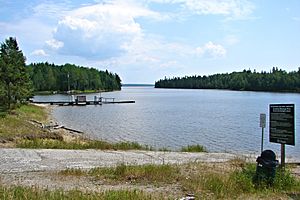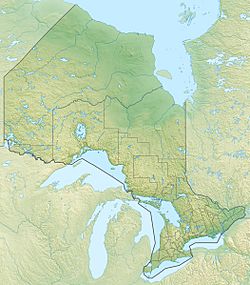Lac Seul facts for kids
Quick facts for kids Lac Seul |
|
|---|---|

Boat launch on Lac Seul at Ear Falls
|
|
| Location | Kenora District, Ontario |
| Coordinates | 50°20′N 92°30′W / 50.333°N 92.500°W |
| Primary inflows | Vermilion River |
| Primary outflows | English River |
| Basin countries | Canada |
| Surface area | 1,657 km2 (640 sq mi) |
| Max. depth | 47.2 m (155 ft) |
| Surface elevation | 357 m (1,171 ft) |
Lac Seul is a big, crescent-shaped reservoir in northwestern Ontario, Canada. A reservoir is like a large, natural lake that has been made bigger by humans, often with a dam, to store water. Lac Seul is about 241 kilometers (150 miles) long. It's the second largest body of water completely inside Ontario, after Lake Nipigon.
The lake has a maximum depth of about 47 meters (155 feet). Its water level is controlled. It goes up in the summer and down in the winter. This helps with power generation. Lac Seul has many open bays, narrow channels, and islands. It's a fairly shallow lake with lots of rocky areas. These spots are perfect homes for many fish.
Contents
About Lac Seul
Lac Seul sits on what used to be the bottom of a huge ancient lake called Glacial Lake Agassiz. Because of this, much of the lakebed is covered with thick layers of fine mud and clay. The water in Lac Seul has a unique tea color. This color is great for fishing!
Fishing Fun
The tea-colored water of Lac Seul is perfect for Walleye and Northern pike. Walleye usually only feed at dawn and dusk because their eyes are sensitive to light. But in Lac Seul's darker water, they can hunt all day long. This makes for excellent fishing opportunities.
You can also find other fish like whitefish, tullibee, burbot, and cisco here. Lac Seul is known for having some of the best fishing in Ontario. Many people visit to try and catch a trophy-sized Northern Pike or Walleye.
Wildlife Around the Lake
The many islands on Lac Seul are very important. They provide a special place for the rare boreal woodland caribou to have their babies. These caribou are a type of deer that lives in northern forests. Protecting these islands helps keep the caribou safe.
How Lac Seul Helps Generate Power
The amount of water in Lac Seul is increased by bringing in water from the Albany River area. This extra water helps power hydroelectric stations. These stations use the force of moving water to create electricity. The stations at Ear Falls and Manitou Falls use water from Lac Seul to make a lot of electricity.
A Look Back in Time
Long ago, during the fur trade, Lac Seul was an important part of a canoe route. This route connected James Bay to Lake Winnipeg. Traders would travel by canoe from James Bay, along the Albany River, through Lake St. Joseph, then portage (carry their canoes) to Lac Seul. From there, they would follow the English River to the Winnipeg River and finally to Lake Winnipeg. This route was vital for moving furs and supplies.
Nearby Communities
- Ear Falls, Ontario
- Goldpines, Ontario
- Lac Seul First Nation - Lac Seul 28 Indian Reserve
- Lac Seul Post, Ontario
- Sioux Lookout, Ontario
- Wabauskang First Nation - Wabauskang 21 Indian Reserve
- Hudson, Kenora District, Ontario
Tributaries
See also
 In Spanish: Lago Seul para niños
In Spanish: Lago Seul para niños


